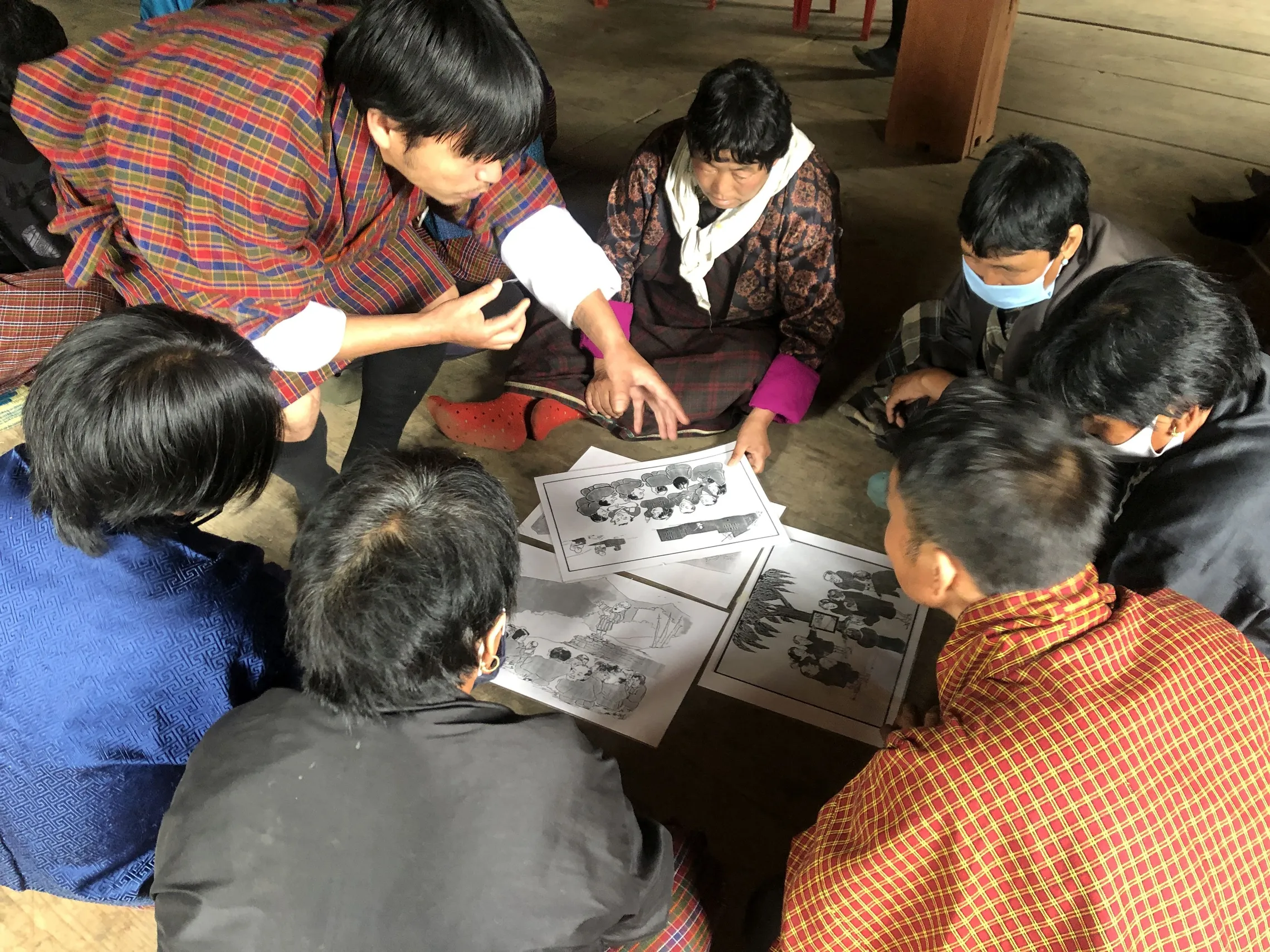#RecoveringBetter
Connecting every person to an improved toilet by 2022: presenting insights of district-level sanitation movers, heroes, and experts in Bhutan.

Bhutan has come a long way in its sanitation and hygiene programming. Before the government-led Rural Sanitation and Hygiene Programme (RSAHP) was formed in 2008, just a little over half of the population had access to basic sanitation and hygiene facilities. Today, with support from SNV and UNICEF, key partners of the Government of Bhutan, the target of 100% improved sanitation (not basic!) by end 2022 is well within reach.

Bhutan’s achievements result from a strong commitment by government to deliver to the human rights of everybody. This includes, among others, the right to health, the right to water and sanitation, and the right to participation, regardless of identity markers such as gender, ability, income, age, etc.
In our latest WASH blog series, we focus on the success of RSAHP Community Development for Health workshops in building the capacity of partners to carry out sanitation and hygiene behavioural change activities.[1] [2] In this compilation, we offer a platform for the voices of our health assistant, village health worker, and gewog (group of villages) and Dzongkhag (district) government official partners. They are the real movers, heroes, and experts of rural sanitation behavioural change communications. Because of them, Bhutan is already well on its way to #RecoveringBetter.[3]

Ganglapong’s clean village and closing the sanitation ‘distance’ gap
In 2020, 100% of Ganglapong’s population started enjoying access to pour flush toilets and safe drinking water. These improvements – in facility access and practice – have not only delivered to the community’s right to water and sanitation, as well, facilitated the reduction of preventative disease incidences.
Gesarling: What it took to achieve 100% sanitation and hygiene
In Gesarling, toilets and their hygienic condition and maintenance were hardly prioritised by the community. For sanitation and hygiene conditions to improve in Gesarling, transforming people’s mindsets was one of the most important strategies to take to realise change.
Pabjee: proof that change, no matter the distance and age, is possible
In a little over a year, the remote and tiny village of Pabjee, which is predominantly populated by senior residents, became the first village in Lhmaoyzingkja’s gewog (group of villages) to gain 100% improved sanitation. In this blog, Health Assistant Men Singh Lepcha shares a timeline of Pabjee village’s sanitation success.
Rabtey: How sanitation and hygiene transformed community health
Prior to RSAHP implementation in Rabtey, there was limited interest to construct a toilet. This despite repeated awareness raising initiatives. There was also a low sense of urgency to construct a toilet since no one in the neighbourhood owned a decent toilet. Two strategies were key to raising interest for change.
Sengdhyen: A tale of sanitation and hygiene success by a health worker
‘Sengdhyen will never achieve 100%,’ said one government official during the early days of the RSAHP. But to everyone’s surprise, Sengdhyen became the first village to achieve 100% improved sanitation and hygiene in Samtse district. Here, I share Sengdhyen's story: an achievement realised through hard work, timely planning, and implementation.
Thomgang: Sanitation and hygiene for all, and by all
Access to proper sanitation and hygiene facilities is a basic right of all people, including people with disabilities. The denial of this right can have serious implications on their wellbeing. The current pandemic has just reminded us – once again – of the need to double sanitation and hygiene efforts to reach all.
Toedtsho: Where toilet facilities outnumber households
In 2017, Toedtsho only registered 38 pour flush toilets for a household count of 88. Today, improved toilets outnumber households. This is a success story that heroes multi-stakeholder approaches as a method to overcome the challenges of poor sanitation and hygiene.
Toep: Aum Mindu’s pour flush toilet
Sanitation demand triggering sparked immediate interest for Toep residents to build their toilets. But for 75-year old Aum Mindu who relied financially on her granddaughter, a pour flush toilet was beyond reach. This is how the community came together to ensure that no one was left behind from the gewog’s sanitation improvements.
Tsakaling: Alone we can do little, together we can do so much
In Bhutan, pathways to realise 100% sanitation and hygiene are designed collaboratively. Four years ago, Tsakaling gewog and 13 other gewogs received government certifications for accomplishing 100% improved sanitation. Read how doing things together create ripples of change.
Tshangka: Building for life
Sustainable sanitation begins with a toilet that is accessible, captures human waste in a safe manner, and offers a dignified and private space for cleaning up. In 2018, a little over half of Tshangka gewog’s residents had access to an improved toilet (58%). Today, everybody enjoys this access.
Notes
[1] CDH workshops are demand creation/triggering workshops that combine selected elements from the Community-Led Total Sanitation (CLTS) and Participatory Hygiene and Sanitation Transformation (PHAST) approaches. CDH workshops are tailored to the needs of diverse village and household settings in rural Bhutan. Creating demand, ownership, and linking demand with sanitation technology options, products and services are the main elements of CDH workshops. So are strengthening the participation and voice of people with disabilities, people living in poverty, and women.
[2] SNV’s rural sanitation work in Bhutan is currently supported by the Australian Government’s Water for Women Fund.
[3] #RecoveringBetter is this year’s International Human Rights Day global call to action. In light of the COVID-19 pandemic and its likely impacts in deepening poverty, vulnerabilities, and inequities, going forward, the UN challenges the world to ramp up efforts to end discrimination of any kind, address inequalities, encourage participation and solidarity, and promote sustainable development.
Banner photo: SNV/Aidan Dockery
For more information on SNV’s CDH-related activities, contact the Water team in SNV's office in Bhutan.